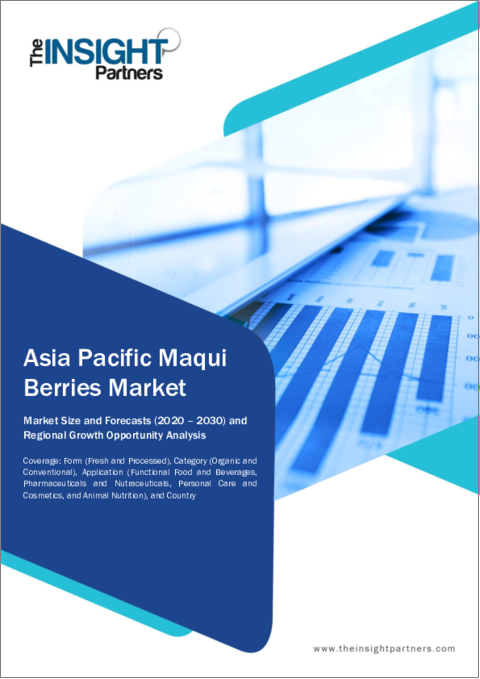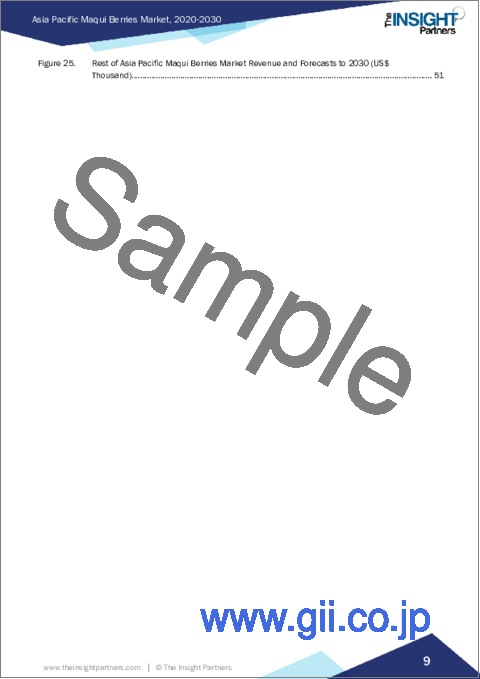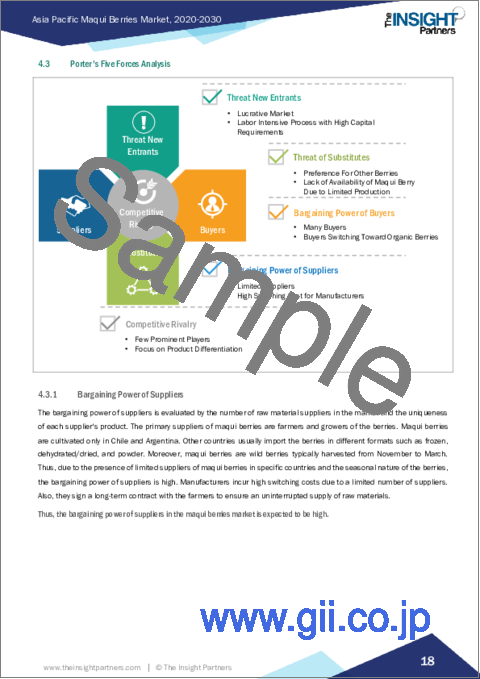|
|
市場調査レポート
商品コード
1533139
アジア太平洋地域のマキベリー市場予測(~2030年):地域別分析-形態、カテゴリー、用途別Asia Pacific Maqui Berries Market Forecast to 2030 - Regional Analysis - by Form, Category, and Application |
||||||
|
|||||||
| アジア太平洋地域のマキベリー市場予測(~2030年):地域別分析-形態、カテゴリー、用途別 |
|
出版日: 2024年06月04日
発行: The Insight Partners
ページ情報: 英文 62 Pages
納期: 即納可能
|
全表示
- 概要
- 図表
- 目次
アジア太平洋地域のマキベリー市場は、2022年の956万米ドルから2030年には2,402万米ドルに成長すると予想されています。2022年から2030年までのCAGRは12.2%を記録すると推定されます。
目の健康をサポートするマキベリーエキス配合の医薬品開拓がアジア太平洋地域のマキベリー市場を後押し
ドライアイは、目の涙腺から十分な涙が分泌されず、目の潤いが保てなくなることで起こります。その結果、目の炎症、充血、光に対する過敏性、目のかすみ、チクチク感や灼熱感を引き起こします。ドライアイを放置しておくと、深刻な目の炎症、角膜潰瘍、角膜表面の擦り傷、視力低下を引き起こす可能性があります。マキベリーは抗酸化物質が豊富なスーパーフルーツであるため、炎症を抑え、自然な涙の分泌を増やし、涙の質を改善することで、ドライアイの症状を軽減することができると考えられています。
2015年、日本の科学者たちは、マキベリーエキスから作られた内服薬が、市販の目薬を使わずにドライアイ症候群を緩和できることを発見しました。これらの経口サプリメントは、健康的な涙液の生成をサポートし、人工涙液に代わるより安全なものです。同社はまた、ドライアイの不快感に対するマキブライト・エキスの効果を確認する試験も行いました。参加者からは、涙の分泌量とドライアイの不快感が大幅に改善したとの報告がありました。このように、目の健康をサポートするマキベリーエキスを使った革新的な医薬品やサプリメントの発展は、今後数年間でアジア太平洋地域のマキベリー市場に有利な機会をもたらすと期待されています。
アジア太平洋地域のマキベリー市場概要
アジア太平洋はマキベリーの新興市場の一つです。アジア太平洋地域のマキベリー市場は、中国、日本、インド、オーストラリア、韓国、その他アジア太平洋地域に区分されます。韓国、オーストラリア、日本などはマキベリーの主要輸入国です。目の健康をターゲットとする栄養補助食品メーカーは、マキベリーに含まれるアントシアニンとフラボノイドの存在により、ますますマキベリーを製品に使用するようになっています。アントシアニンは網膜の酸化ストレスを軽減し、炎症を抑え、抗アレルギー作用と抗菌作用をもたらし、目の細い毛細血管を通して血液循環をサポートします。そのため、目のサプリメント分野でマキベリーの需要が高まっています。2021年2月、美容・健康サプリメントのナノ・ジャパンは、ルテイン、アスタキサンチン、マキベリーエキス、カシス、ビタミンB、ケルセチン、クロマニン-10を配合した液体サプリメント「ナノ・オプティビュー」を発売しました。同社は、このサプリメントがデジタル眼精疲労や疲労を軽減し、集中力を向上させるとしています。ナノ・ジャパンは、シンガポール、マレーシア、日本を含む市場で製品を発売し、東南アジア全域に地理的なリーチを拡大する計画です。
さらに、マキベリーを主成分とするスキンケア製品は、アジア太平洋諸国、特に韓国、インド、オーストラリアで大きな需要があります。この地域の人々は、スキンケア製品や化粧品に含まれる有毒化学物質の有害な影響に対する意識の高まりから、自然なスキンケアに注目しています。ベリーを配合した製品への嗜好は、その美白、浄化、アンチエイジング効果により著しく高まっています。この要因は、今後数年間、アジア太平洋地域のマキベリー市場に大きな機会を提供すると期待されています。
アジア太平洋地域のマキベリー市場の収益と2030年までの予測(金額)
アジア太平洋地域のマキベリー市場のセグメンテーション
アジア太平洋地域のマキベリー市場は、形態、カテゴリー、用途、国に区分されます。
形態別に見ると、アジア太平洋地域のマキベリー市場は生鮮品と加工品に二分されます。2022年のアジア太平洋地域のマキベリー市場では、加工品セグメントが大きなシェアを占めています。
カテゴリー別では、アジア太平洋地域のマキベリー市場は有機と慣行に二分されます。2022年のアジア太平洋地域のマキベリー市場では、慣行栽培セグメントがより大きなシェアを占めています。
用途別では、アジア太平洋地域のマキベリー市場は機能性食品・飲料、医薬品・栄養補助食品、パーソナルケア・化粧品、動物栄養に区分されます。2022年のアジア太平洋地域のマキベリー市場では、機能性食品・飲料分野が最大のシェアを占めています。
国別に見ると、アジア太平洋地域のマキベリー市場は中国、日本、インド、オーストラリア、韓国、その他アジア太平洋地域に区分されます。その他アジア太平洋地域が2022年のアジア太平洋地域のマキベリー市場を独占します。
HP Ingredients Corp、Jeeva Organic Pvt Ltd、Shaanxi LonierHerb Bio-Technology Co Ltd、Xi'an Herb Bio-Tech Co Ltdは、アジア太平洋地域のマキベリー市場で事業展開している大手企業です。
目次
第1章 イントロダクション
第2章 エグゼクティブサマリー
- 主要洞察
- 市場の魅力
第3章 調査手法
- 調査範囲
- 2次調査
- 1次調査
- 制限と前提条件
第4章 アジア太平洋地域のマキベリー市場情勢
- ポーターのファイブフォース分析
- ポーターのファイブフォース分析
- 供給企業の交渉力
- 買い手の交渉力
- 新規参入業者の脅威
- 競争企業間の敵対関係
- 代替品の脅威
- エコシステム分析
第5章 アジア太平洋地域のマキベリー市場:主要産業力学
- 市場促進要因
- 機能性食品・飲食品におけるマキベリー利用の増加
- 糖尿病用サプリメントにおけるマキベリーの利用
- 市場抑制要因
- マキベリーの供給制限
- 市場機会
- 目の健康をサポートするマキベリーエキス配合医薬品の開発
- 今後の動向
- マキベリー配合スキンケア製品の人気上昇
- 促進要因と抑制要因の影響
第6章 マキベリー市場:アジア太平洋市場分析
- アジア太平洋地域のマキベリー市場収入(2020年~2030年)
- アジア太平洋地域のマキベリー市場の予測と分析
第7章 アジア太平洋地域のマキベリー市場分析:形態別
- 生鮮品
- 生鮮品:2030年までの市場収益と予測
- 加工品
- 加工品:2030年までの市場収益と予測
第8章 アジア太平洋地域のマキベリー市場分析:カテゴリー別
- 有機
- 有機:2030年までの市場収益と予測
- 慣行
- 慣行:2030年までの市場収益と予測
第9章 アジア太平洋地域のマキベリー市場分析:用途別
- 機能性食品・飲食品
- 機能性食品・飲食品:2030年までの市場収益と予測
- 医薬品・栄養補助食品
- 医薬品・栄養補助食品:2030年までの市場収益と予測
- パーソナルケア・化粧品
- パーソナルケア・化粧品:2030年までの市場収益と予測
- 動物栄養
- 動物栄養:2030年までの市場収益と予測
第10章 アジア太平洋地域のマキベリー市場:国別分析
- 中国
- 日本
- インド
- オーストラリア
- 韓国
- その他アジア太平洋地域
第11章 企業プロファイル
- HP Ingredients Corp
- Shaanxi LonierHerb Bio-Technology Co Ltd
- Jeeva Organic Pvt Ltd
- Xi'an Herb Bio-Tech Co Ltd
第12章 付録
List Of Tables
- Table 1. Asia Pacific Maqui Berries Market Segmentation
- Table 2. Delphinidin Content of "Superfruit" Berries
- Table 3. Asia Pacific Maqui Berries Market Revenue and Forecasts to 2030 (US$ Thousand)
- Table 4. China Maqui Berries Market Revenue and Forecasts to 2030 (US$ Thousand) - Form
- Table 5. China Maqui Berries Market Revenue and Forecasts to 2030 (US$ Thousand) - Category
- Table 6. China Maqui Berries Market Revenue and Forecasts to 2030 (US$ Thousand) - Application
- Table 7. Japan Maqui Berries Market Revenue and Forecasts to 2030 (US$ Thousand) - Form
- Table 8. Japan Maqui Berries Market Revenue and Forecasts to 2030 (US$ Thousand) - Category
- Table 9. Japan Maqui Berries Market Revenue and Forecasts to 2030 (US$ Thousand) - Application
- Table 10. India Maqui Berries Market Revenue and Forecasts to 2030 (US$ Thousand) - Form
- Table 11. India Maqui Berries Market Revenue and Forecasts to 2030 (US$ Thousand) - Category
- Table 12. India Maqui Berries Market Revenue and Forecasts to 2030 (US$ Thousand) - Application
- Table 13. Australia Maqui Berries Market Revenue and Forecasts to 2030 (US$ Thousand) - Form
- Table 14. Australia Maqui Berries Market Revenue and Forecasts to 2030 (US$ Thousand) - Category
- Table 15. Australia Maqui Berries Market Revenue and Forecasts to 2030 (US$ Thousand) - Application
- Table 16. South Korea Maqui Berries Market Revenue and Forecasts to 2030 (US$ Thousand) - Form
- Table 17. South Korea Maqui Berries Market Revenue and Forecasts to 2030 (US$ Thousand) - Category
- Table 18. South Korea Maqui Berries Market Revenue and Forecasts to 2030 (US$ Thousand) - Application
- Table 19. Rest of Asia Pacific Maqui Berries Market Revenue and Forecasts to 2030 (US$ Thousand) - Form
- Table 20. Rest of Asia Pacific Maqui Berries Market Revenue and Forecasts to 2030 (US$ Thousand) - Category
- Table 21. Rest of Asia Pacific Maqui Berries Market Revenue and Forecasts to 2030 (US$ Thousand) - Application
List Of Figures
- Figure 1. Asia Pacific Maqui Berries Market Segmentation, By Country
- Figure 2. Ecosystem: Asia Pacific Maqui Berries Market
- Figure 3. Asia Pacific Maqui Berries Market - Key Industry Dynamics
- Figure 4. Oxygen Radical Absorbance Capacity (ORAC) of Different Berries Measured in Micromoles Trolox Equivalents (TE) Per 100 Gram of the Raw Fruit
- Figure 5. Impact Analysis of Drivers and Restraints
- Figure 6. Asia Pacific Maqui Berries Market Revenue (US$ Thousand), 2020 - 2030
- Figure 7. Asia Pacific Maqui Berries Market Share (%) - Form, 2022 and 2030
- Figure 8. Fresh Market Revenue and Forecasts to 2030 (US$ Thousand)
- Figure 9. Processed Market Revenue and Forecasts to 2030 (US$ Thousand)
- Figure 10. Asia Pacific Maqui Berries Market Share (%) -Category, 2022 and 2030
- Figure 11. Organic Market Revenue and Forecasts to 2030 (US$ Thousand)
- Figure 12. Conventional Market Revenue and Forecasts to 2030 (US$ Thousand)
- Figure 13. Asia Pacific Maqui Berries Market Share (%) -Application, 2022 and 2030
- Figure 14. Functional Food and Beverages Market Revenue and Forecasts to 2030 (US$ Thousand)
- Figure 15. Pharmaceuticals and Nutraceuticals Market Revenue and Forecasts to 2030 (US$ Thousand)
- Figure 16. Personal Care and Cosmetics Market Revenue and Forecasts to 2030 (US$ Thousand)
- Figure 17. Animal Nutrition Market Revenue and Forecasts to 2030 (US$ Thousand)
- Figure 18. Asia Pacific Maqui Berries Market, By Key Country - Revenue (2022) (US$ Thousand)
- Figure 19. Asia Pacific Maqui Berries Market Breakdown By Key Countries, 2022 And 2030 (%)
- Figure 20. China Maqui Berries Market Revenue and Forecasts to 2030 (US$ Thousand)
- Figure 21. Japan Maqui Berries Market Revenue and Forecasts to 2030 (US$ Thousand)
- Figure 22. India Maqui Berries Market Revenue and Forecasts to 2030 (US$ Thousand)
- Figure 23. Australia Maqui Berries Market Revenue and Forecasts to 2030 (US$ Thousand)
- Figure 24. South Korea Maqui Berries Market Revenue and Forecasts to 2030 (US$ Thousand)
- Figure 25. Rest of Asia Pacific Maqui Berries Market Revenue and Forecasts to 2030 (US$ Thousand)
The Asia Pacific maqui berries market is expected to grow from US$ 9.56 million in 2022 to US$ 24.02 million by 2030. It is estimated to record a CAGR of 12.2% from 2022 to 2030.
Development of Medicines with Maqui Berry Extracts that Support Eye Health Boosts Asia Pacific Maqui Berries Market
Dry eye happens when tear glands in the eyes do not make enough tears to stay wet and lubricated. This causes irritation in the eyes, redness, sensitivity to light, blurry vision, and a stinging or burning feeling. Dry eyes, if left untreated, can cause severe eye inflammation, corneal ulcers, abrasion of corneal surface, and vision loss. Since maqui berries are antioxidant-rich superfruits, it is seen that they can help reduce dry eye symptoms by reducing inflammation, increasing natural tear production, and improving tear quality.
In 2015, scientists in Japan discovered that oral medication made from maqui berry extracts can alleviate dry eye syndrome without using commercial eye drops. These oral supplements support healthy tear fluid generation and is a safer alternative to artificial tears. The company also conducted trials to see the effect of MaquiBright extract on dry eye discomfort. The participants reported significant improvement in tear production and dry eye discomfort. Thus, the rising development of innovative medicines and supplements with maqui berry extracts that support eye health is expected to open lucrative opportunities for the Asia Pacific maqui berry market in the coming years.
Asia Pacific Maqui Berries Market Overview
Asia Pacific is one of the emerging markets for maqui berries. The Asia Pacific maqui berries market is segmented into China, Japan, India, Australia, South Korea, and the Rest of Asia Pacific. Countries such as South Korea, Australia, and Japan are among the major importers of maqui berries. The dietary supplement manufacturers targeting eye health are increasingly using maqui berries in their products due to the presence of anthocyanins and flavonoids in maqui berries. Anthocyanins reduce oxidative stress in the retina, reduce inflammation, provide antiallergic and antimicrobial effects, and support blood circulation through fine capillaries in the eye. Thus, the demand for maqui berries is rising in the eye supplements space. In February 2021, Nano Japan, a beauty and health supplements company, launched Nano Optivue, a liquid supplement containing lutein, astaxanthin, maqui berry extract, blackcurrant, vitamin B, quercetin, and kuromanin-10. The company claims that the supplement can reduce digital eye strain and fatigue and improve focus. Nano Japan is planning to expand its geographical reach across Southeast Asia with the launch of its products in markets, including Singapore, Malaysia, and Japan.
Further, skin care products with maqui berries as a key ingredient are witnessing heavy demand in Asia Pacific countries, especially South Korea, India, and Australia. People in the region are focusing on natural skin care due to rising awareness of the harmful effects of toxic chemicals present in skin care products and cosmetics. The preference for berry-infused products is increasing significantly due to their brightening, purifying, and antiaging effects. This factor is expected to provide immense opportunities for the maqui berries market in Asia Pacific in the coming years.
Asia Pacific Maqui Berries Market Revenue and Forecast to 2030 (US$ Million)
Asia Pacific Maqui Berries Market Segmentation
The Asia Pacific maqui berries market is segmented into form, category, application, and country.
Based on form, the Asia Pacific maqui berries market is bifurcated into fresh and processed. The processed segment held a larger share of the Asia Pacific maqui berries market in 2022.
In terms of category, the Asia Pacific maqui berries market is bifurcated into organic and conventional. The conventional segment held a larger share of the Asia Pacific maqui berries market in 2022.
By application, the Asia Pacific maqui berries market is segmented into functional food and beverage, pharmaceuticals and nutraceuticals, personal care and cosmetics, and animal nutrition. The functional food and beverage segment held the largest share of the Asia Pacific maqui berries market in 2022.
Based on country, the Asia Pacific maqui berries market is segmented into China, Japan, India, Australia, South Korea, and the Rest of Asia Pacific. The Rest of Asia Pacific dominated Asia Pacific maqui berries market in 2022.
HP Ingredients Corp, Jeeva Organic Pvt Ltd, Shaanxi LonierHerb Bio-Technology Co Ltd, and Xi'an Herb Bio-Tech Co Ltd are some of the leading companies operating in the Asia Pacific maqui berries market.
Table Of Contents
1. Introduction
- 1.1 The Insight Partners Research Report Guidance
- 1.2 Market Segmentation
2. Executive Summary
- 2.1 Key Insights
- 2.2 Market Attractiveness
3. Research Methodology
- 3.1 Coverage
- 3.2 Secondary Research
- 3.3 Primary Research
- 3.4 Limitations and Assumptions
4. Asia Pacific Maqui Berries Market Landscape
- 4.1 Overview
- 4.2 Porter's Five Forces Analysis
- 4.3 Porter's Five Forces Analysis
- 4.3.1 Bargaining Power of Suppliers
- 4.3.2 Bargaining Power of Buyers
- 4.3.3 Threat of New Entrants
- 4.3.4 Competitive Rivalry
- 4.3.4.1 Threat of Substitutes
- 4.4 Ecosystem Analysis
5. Asia Pacific Maqui Berries Market - Key Industry Dynamics
- 5.1 Market Drivers
- 5.1.1 Increasing Use of Maqui Berries in Functional Food and Beverages
- 5.1.2 Utilization of Maqui Berries in Supplements for Diabetes
- 5.2 Market Restraints
- 5.2.1 Limited Supply of Maqui Berries
- 5.3 Market Opportunities
- 5.3.1 Development of Medicines with Maqui Berry Extracts that Support Eye Health
- 5.4 Future Trends
- 5.4.1 Rising Popularity of Skin Care Products with Maqui Berry
- 5.5 Impact of Drivers and Restraints:
6. Maqui Berries Market - Asia Pacific Market Analysis
- 6.1 Asia Pacific Maqui Berries Market Revenue (US$ Thousand), 2020 - 2030
- 6.2 Asia Pacific Maqui Berries Market Forecast and Analysis
7. Asia Pacific Maqui Berries Market Analysis - Form
- 7.1 Fresh
- 7.1.1 Overview
- 7.1.2 Fresh Market Revenue and Forecast to 2030 (US$ Thousand)
- 7.2 Processed
- 7.2.1 Overview
- 7.2.2 Processed Market Revenue and Forecast to 2030 (US$ Thousand)
8. Asia Pacific Maqui Berries Market Analysis - Category
- 8.1 Organic
- 8.1.1 Overview
- 8.1.2 Organic Market Revenue and Forecast to 2030 (US$ Thousand)
- 8.2 Conventional
- 8.2.1 Overview
- 8.2.2 Conventional Market Revenue and Forecast to 2030 (US$ Thousand)
9. Asia Pacific Maqui Berries Market Analysis - Application
- 9.1 Functional Food and Beverages
- 9.1.1 Overview
- 9.1.2 Functional Food and Beverages Market Revenue and Forecast to 2030 (US$ Thousand)
- 9.2 Pharmaceuticals and Nutraceuticals
- 9.2.1 Overview
- 9.2.2 Pharmaceuticals and Nutraceuticals Market Revenue and Forecast to 2030 (US$ Thousand)
- 9.3 Personal Care and Cosmetics
- 9.3.1 Overview
- 9.3.2 Personal Care and Cosmetics Market Revenue and Forecast to 2030 (US$ Thousand)
- 9.4 Animal Nutrition
- 9.4.1 Overview
- 9.4.2 Animal Nutrition Market Revenue and Forecast to 2030 (US$ Thousand)
10. Asia Pacific Maqui Berries Market - Country Analysis
- 10.1 Asia Pacific Maqui Berries Market
- 10.1.1 Overview
- 10.1.2 Asia Pacific Maqui Berries Market, By Key Country - Revenue (2022) (US$ Thousand)
- 10.1.2.1 Asia Pacific Maqui Berries Market Breakdown by Country
- 10.1.2.2 China Maqui Berries Market Revenue and Forecasts to 2030 (US$ Thousand)
- 10.1.2.2.1 China Maqui Berries Market Breakdown by Form
- 10.1.2.2.2 China Maqui Berries Market Breakdown by Category
- 10.1.2.2.3 China Maqui Berries Market Breakdown by Application
- 10.1.2.3 Japan Maqui Berries Market Revenue and Forecasts to 2030 (US$ Thousand)
- 10.1.2.3.1 Japan Maqui Berries Market Breakdown by Form
- 10.1.2.3.2 Japan Maqui Berries Market Breakdown by Category
- 10.1.2.3.3 Japan Maqui Berries Market Breakdown by Application
- 10.1.2.4 India Maqui Berries Market Revenue and Forecasts to 2030 (US$ Thousand)
- 10.1.2.4.1 India Maqui Berries Market Breakdown by Form
- 10.1.2.4.2 India Maqui Berries Market Breakdown by Category
- 10.1.2.4.3 India Maqui Berries Market Breakdown by Application
- 10.1.2.5 Australia Maqui Berries Market Revenue and Forecasts to 2030 (US$ Thousand)
- 10.1.2.5.1 Australia Maqui Berries Market Breakdown by Form
- 10.1.2.5.2 Australia Maqui Berries Market Breakdown by Category
- 10.1.2.5.3 Australia Maqui Berries Market Breakdown by Application
- 10.1.2.6 South Korea Maqui Berries Market Revenue and Forecasts to 2030 (US$ Thousand)
- 10.1.2.6.1 South Korea Maqui Berries Market Breakdown by Form
- 10.1.2.6.2 South Korea Maqui Berries Market Breakdown by Category
- 10.1.2.6.3 South Korea Maqui Berries Market Breakdown by Application
- 10.1.2.7 Rest of Asia Pacific Maqui Berries Market Revenue and Forecasts to 2030 (US$ Thousand)
- 10.1.2.7.1 Rest of Asia Pacific Maqui Berries Market Breakdown by Form
- 10.1.2.7.2 Rest of Asia Pacific Maqui Berries Market Breakdown by Category
- 10.1.2.7.3 Rest of Asia Pacific Maqui Berries Market Breakdown by Application
11. Company Profiles
- 11.1 HP Ingredients Corp
- 11.1.1 Key Facts
- 11.1.2 Business Description
- 11.1.3 Products and Services
- 11.1.4 Financial Overview
- 11.1.5 SWOT Analysis
- 11.1.6 Key Developments
- 11.2 Shaanxi LonierHerb Bio-Technology Co Ltd
- 11.2.1 Key Facts
- 11.2.2 Business Description
- 11.2.3 Products and Services
- 11.2.4 Financial Overview
- 11.2.5 SWOT Analysis
- 11.2.6 Key Developments
- 11.3 Jeeva Organic Pvt Ltd
- 11.3.1 Key Facts
- 11.3.2 Business Description
- 11.3.3 Products and Services
- 11.3.4 Financial Overview
- 11.3.5 SWOT Analysis
- 11.3.6 Key Developments
- 11.4 Xi'an Herb Bio-Tech Co Ltd
- 11.4.1 Key Facts
- 11.4.2 Business Description
- 11.4.3 Products and Services
- 11.4.4 Financial Overview
- 11.4.5 SWOT Analysis
- 11.4.6 Key Developments





